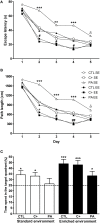Life-long environmental enrichment counteracts spatial learning, reference and working memory deficits in middle-aged rats subjected to perinatal asphyxia
- PMID: 25601829
- PMCID: PMC4283640
- DOI: 10.3389/fnbeh.2014.00406
Life-long environmental enrichment counteracts spatial learning, reference and working memory deficits in middle-aged rats subjected to perinatal asphyxia
Abstract
Continuous environmental stimulation induced by exposure to enriched environment (EE) has yielded cognitive benefits in different models of brain injury. Perinatal asphyxia results from a lack of oxygen supply to the fetus and is associated with long-lasting neurological deficits. However, the effects of EE in middle-aged rats suffering perinatal asphyxia are unknown. Therefore, the aim of the present study was to assess whether life-long exposure to EE could counteract the cognitive and behavioral alterations in middle-aged asphyctic rats. Experimental groups consisted of rats born vaginally (CTL), by cesarean section (C+), or by C+ following 19 min of asphyxia at birth (PA). At weaning, rats were assigned to standard (SE) or enriched environment (EE) for 18 months. During the last month of housing, animals were submitted to a behavioral test battery including Elevated Plus Maze, Open Field, Novel Object Recognition and Morris water maze (MWM). Results showed that middle-aged asphyctic rats, reared in SE, exhibited an impaired performance in the spatial reference and working memory versions of the MWM. EE was able to counteract these cognitive impairments. Moreover, EE improved the spatial learning performance of middle-aged CTL and C+ rats. On the other hand, all groups reared in SE did not differ in locomotor activity and anxiety levels, while EE reduced locomotion and anxiety, regardless of birth condition. Recognition memory was altered neither by birth condition nor by housing environment. These results support the importance of environmental stimulation across the lifespan to prevent cognitive deficits induced by perinatal asphyxia.
Keywords: aging; anxiety; environmental enrichment; habituation; perinatal asphyxia; recognition memory; spatial reference memory; spatial working memory.
Figures






Similar articles
-
Long-lasting effects of perinatal asphyxia on exploration, memory and incentive downshift.Int J Dev Neurosci. 2011 Oct;29(6):609-19. doi: 10.1016/j.ijdevneu.2011.05.002. Epub 2011 May 27. Int J Dev Neurosci. 2011. PMID: 21640811
-
Environmental Enrichment During Adolescence Mitigates Cognitive Deficits and Alcohol Vulnerability due to Continuous and Intermittent Perinatal Alcohol Exposure in Adult Rats.Front Behav Neurosci. 2020 Sep 25;14:583122. doi: 10.3389/fnbeh.2020.583122. eCollection 2020. Front Behav Neurosci. 2020. PMID: 33100982 Free PMC article.
-
Effects of environmental enrichment on anxiety responses, spatial memory and cytochrome c oxidase activity in adult rats.Brain Res Bull. 2013 Sep;98:1-9. doi: 10.1016/j.brainresbull.2013.06.006. Epub 2013 Jul 4. Brain Res Bull. 2013. PMID: 23831916
-
Environmental enrichment improves cognitive function, learning, memory and anxiety-related behaviours in rodent models of dementia: Implications for future study.Neurobiol Learn Mem. 2024 Feb;208:107880. doi: 10.1016/j.nlm.2023.107880. Epub 2023 Dec 14. Neurobiol Learn Mem. 2024. PMID: 38103676 Review.
-
Environmental Enrichment in Stroke Research: an Update.Transl Stroke Res. 2024 Apr;15(2):339-351. doi: 10.1007/s12975-023-01132-w. Epub 2023 Jan 31. Transl Stroke Res. 2024. PMID: 36717476 Review.
Cited by
-
Rearing in a Shelved Environment Chronically Modifies Offspring Behaviour and Physiology.Eur J Neurosci. 2025 Jul;62(2):e70199. doi: 10.1111/ejn.70199. Eur J Neurosci. 2025. PMID: 40685518 Free PMC article.
-
Cognitive function in toddlers with congenital heart disease: The impact of a stimulating home environment.Infancy. 2021 Jan;26(1):184-199. doi: 10.1111/infa.12376. Epub 2020 Nov 19. Infancy. 2021. PMID: 33210418 Free PMC article.
-
Palmitoylethanolamide Ameliorates Hippocampal Damage and Behavioral Dysfunction After Perinatal Asphyxia in the Immature Rat Brain.Front Neurosci. 2018 Mar 28;12:145. doi: 10.3389/fnins.2018.00145. eCollection 2018. Front Neurosci. 2018. PMID: 29662433 Free PMC article.
-
GlyT1 Inhibition by NFPS Promotes Neuroprotection in Amyloid-β-Induced Alzheimer's Disease Animal Model.Neurochem Res. 2024 Sep;49(9):2535-2555. doi: 10.1007/s11064-024-04190-0. Epub 2024 Jun 18. Neurochem Res. 2024. PMID: 38888830
-
Targeting Sentinel Proteins and Extrasynaptic Glutamate Receptors: a Therapeutic Strategy for Preventing the Effects Elicited by Perinatal Asphyxia?Neurotox Res. 2018 Feb;33(2):461-473. doi: 10.1007/s12640-017-9795-9. Epub 2017 Aug 26. Neurotox Res. 2018. PMID: 28844085 Free PMC article. Review.
References
-
- Adcock L. M., Papile L. A. (2008). Perinatal asphyxia, in Manual of Neonatal Care, eds Cloherty J. P., Eichenwald E. C., Stark A. R. (Philadelphia, PA: Lippincott Williams & Wilkins; ), 518–528.
LinkOut - more resources
Full Text Sources
Other Literature Sources

